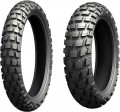Width
Nominal tyre width (section width) in millimetres. This is one of the notation options; in addition to it, there may also be a designation in inches, for more details, see "Width" above.
Width — whether in millimetres or inches — is one of the parameters that determine compatibility with a particular rim (the other parameter is the fit diameter, see above about it). The main criterion for choosing a tyre in width is the manufacturer's recommendations for a given motorcycle model. It is highly undesirable to deviate from these recommendations: although some types of motorcycles (for example, road bikes) allow a width deviation of +/— 10 mm on the rear wheel, such a wheel will still function in a mode that differs from the standard one. On the front wheel, no deviations are allowed at all.
Profile
Tyre profile height. This parameter is specified as a percentage of the profile width (see above).
The higher the profile, the better the motorcycle can carry heavy weight and increased loads when driving on rough roads and the lower its stability at high speeds. Therefore, for high-speed driving on high-quality flat tracks, hard-surface motorcycle tracks, etc. use ultra-low-profile rubber, with a profile height of up to 60%. For most east european roads, given their overall quality, rather low-profile tyres are recommended — 60 — 80%. And tyres with a profile height of more than 80% should be chosen when the key points are not speed, but cross-country ability and resistance to stress.
Now on the market there are tyres with the following profile height:
40%,
50%,
55%,
60%,
65%,
70%,
75%,
80%,
90%,
100%.
Load index
The load index indicates
the maximum weight load that the tyre can safely carry in normal operation. To shorten the marking, this parameter is denoted by a two-digit number; you can translate this designation into a specific weight in kilograms using special tables.
This value must not be exceeded — otherwise the tyre may burst at any time due to off-design loads. At the same time, when choosing motor tyres for this parameter, it is worth remembering that the load is distributed unevenly between the front and rear wheels. However, the task is facilitated by the fact that motorcycle manufacturers can indicate the minimum or recommended load indices for the front and rear axles in the documentation for their equipment.
Tyre type
—
Chamber (TT). Tyres, consisting of a tyre and an internal sealed chamber into which air is pumped. Despite the "double walls", such tyres are inferior in reliability to tubeless ones — they quickly release air when punctured, and in general they have more modest performance characteristics. At the same time, chamber tyres also have advantages: they are insensitive to rim deformations and retain their tightness even when there is a gap between the rim and the tyre. Thus, there are two main areas of application for such tyres today. Firstly, these are spoked wheels, where the rim does not provide tightness and you cannot do without a chamber; such wheels are installed on many east european motorcycles, as well as some choppers. Secondly, tube tyres are used by some extreme riders or long "
enduro " style travel enthusiasts (see "Directionally").
—
Tubeless (TL). Tyres that do not use an inner tube — the air in such models is pumped into the space between the tyre and the wheel rim. This design requires a one-piece rim that does not allow air to pass through, and only works properly on cast wheels, without spokes. On the other hand, the vast majority of modern motorcycles are equipped with such wheels. Tubeless tyres are considered more reliable and safer than tube tyres, they tolerate punctures better (in particular, they hold air longer), and they are easier to rep
...air. Therefore, in general, such tyres are preferable to tube tyres (with the exception of some specific cases described above).
— TT/TL. Tyres that can be installed in both tube and tubeless ways — depending on which option is required in this case, taking into account the type of wheel and application.
